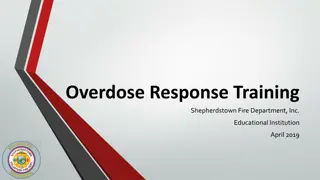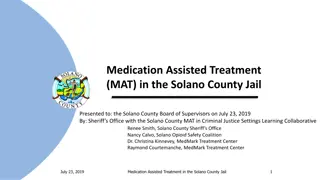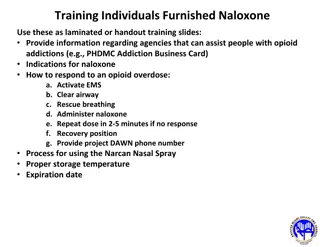Trends in Polysubstance-Involved Opioid Overdose Deaths Among US Youth
Drug overdoses are a significant concern among US youth, with opioids being a major factor. This study analyzes trends in polysubstance-involved opioid overdose deaths from 2020 to 2023, shedding light on the complex nature of these fatalities and potential risk factors.
Download Presentation

Please find below an Image/Link to download the presentation.
The content on the website is provided AS IS for your information and personal use only. It may not be sold, licensed, or shared on other websites without obtaining consent from the author.If you encounter any issues during the download, it is possible that the publisher has removed the file from their server.
You are allowed to download the files provided on this website for personal or commercial use, subject to the condition that they are used lawfully. All files are the property of their respective owners.
The content on the website is provided AS IS for your information and personal use only. It may not be sold, licensed, or shared on other websites without obtaining consent from the author.
E N D
Presentation Transcript
Psychological 1) 2) 3) 4) 5) Makechoicesto solve problems Introduceconceptof teamversus teamgames Concentrationand focus on a task Have playersprovide input Confidence Technical Development Introduceball manipulation techniques 1) Ball Mastery: a. Dribbling andmanipulating theball with both feet ie. Coervermethod. Imagination andcreativity is vital. Controlling the ball on theground with both feetanddifferent surfaces. Control Look -Play Ball juggling. Progression With the Ball: a. Shielding theball. b. Turningwith theball c. Feints andchangeof direction d. Runningwith theball Transmission of the Ball: a. Passing with apartnerusing inside andoutside offeet, upto 3 versus1 Shooting: a. Shooting with bothfeet b. Introducechip, bentshot, volley c. Turning andshooting d. Scoringgoals on nets (funaspectandfreedomofexpression) e. Focus on the accuracyof the shot Defending: a. Introduce1v1 defending b. Introducepressureonanopponentandclosing space c. Introducechallenging fortheball d. Introducejockeying e. Introducethe conceptof goal-side f. Introducewatching theball andtheopponent g. Introducewhen tointerceptthe ball h. Introduceindividual markingaroundthegoal area b. Social/Emotional ActiveStartPhaseAreas of Focus c. d. 1) 2) 3) 4) 5) 6) 7) Cooperationwith others Receivepositive reinforcement Following basicrules Acceptingloss Listening tocoach Making new friends Having Fun! 2) 3) 4) Physical Development 5) 1) BasicMovements Running Jumping, Hopping, Skipping Basic motorskills Agility Balance Co-ordination ofsimple movements, 2) 3) 4) 5)
FundamentalsGuidelines At theseages,playersshouldbetraining2-3 times perweekplusonegame.A size3 or lightersize4 ballfor U8-U9, size4 or lightersize5 ballfor U10, or futsal ball shouldbe usedfor training.Competitiongamesshouldbe 4-asideto 7-aside,basedon theirage and theOntarioSoccerDevelopmentMatrix recommendations. The totalnumberof games in an outdoorseason shouldbe 16-20. Thisis the learningstage and footballis for fun. It takesten yearsof extensive trainingto excelin anysport. Allof thesekey factorsrelateto fieldplayersand goalkeepers. Coaches atthislevelshouldbeveryenthusiasticandpromotethe fun/passion aspectof the game to the players.Theymust understandchildrenand be able to influencetheplayers.Theymust join in the trainingsessionstomotivate the young players.Do not start positionspecializationas it createsemotionalstress and affects physicaldevelopment.Rotate the playersaroundin variouspositions. Begin teachingthe technicalelementsof thegame and playlotsof smallgames with technicalconditions,dueto shortattentionspans.Have playersmasterthe ball and do not play one-touch soccerdueto limitedcontactson theball. Practicetime allotmentshouldbe as follows: 15-20 mins warm up with the ball 15-20 mins small sided game 15-25 mins Activity(randompractise) 20-25 Mins Game 3v3 to 4v4
Social/Emotional Development Goalkeeping TacticalDevelopment 1) 2) 3) 4) 5) 6) Provide problem-solving situations onthe field Have differentplayerslead activities Have playersprovide input Receivepositive reinforcement IntroduceLeadershipskills TeamBonding Activity 1) 2) 3) 4) 5) 6) 7) 8) 9) 1 versus 1 attackinga defenderandgoing to goal. Introducetriangles ofsupport Introducecreatingspace for the individual Introducecombination play Introducegoal-side in defending Introducewing play Small-sided games with no goalkeepers(3v3, 4v4) Goalkeeperslearningto protectthegoal Training in small-sided games. 1. 2. 3. 4. 5. 6. 7. 8. Goalkeepersfielding andhandling theball Introducedistribution with handsand feet Develop footworkandagility Develop thestance Introducethe side dive Introducediving at thefeet ofanattacker Develop the ability to takea goalkick Introducethe goalkeepersupporting the defence Introducethe sweeper-keeperrole Develop communication skills with teammates Introducepositioning in andaroundthe goal area Introducepositioning andcommunication onset plays Technical Development 1) Ball Mastery: a. 9. 10. Dribbling andmanipulating theball with both feet ie. Coervermethod. Imagination andcreativity is vital. Controlling the ball on theground with both feetanddifferent surfaces. Control Look -Play Ball juggling. Progression With the Ball: a. Shielding theball. b. Turning with the ball c. Feints andchangeof direction d. Runningwith theball Transmission of the Ball: a. Passing with apartnerusing inside andoutside offeet, upto 3 versus1 Shooting: a. Shooting with bothfeet b. Introducechip, bentshot, volley c. Turning andshooting d. Scoringgoals on nets (funaspectandfreedomofexpression) e. Focus on the accuracyof the shot Defending: a. Introduce1v1 defending b. Introducepressureonanopponentandclosing space c. Introducechallenging fortheball d. Introducejockeying e. Introducethe conceptof goal-side f. Introducewatching theball andtheopponent g. Introducewhen tointerceptthe ball h. Introduceindividual markingaroundthe goal area b. 11. c. d. 12. 2) FundamentalPhase Areas of Focus 3) 4) Psychological Development 1) 2) 3) 4) 5) Introducerelaxation exercises Introducepositive self talk Introduce concentration exercises Introducegoal setting Introduceimageryandfocusduring games 5) Physical Development 1) Runningstyle (armmovement,leg movement, head position) Turning, changeofdirection and agility. Verticaljump Basic motorskills (learning to anticipate the ball) Balancewhile in controlof the ball Co-ordination while runningwith the ball 2) 3) 4) 5) 6)
LearntoTrainGuidelines In this phase,playersshould betraining3 timesper weekwith sessions90 minutesin length.A size4 or lightersize5 soccer or size5 shouldbe used in trainingand Games should be 7 a-sideor 9-aside,based on theirage and the OntarioSoccer DevelopmentMatrix recommendations. Introduceoffsidesin game situationsfor olderplayersin this phase.The total numberof games in an outdoorseasonshouldbe 16-20. Thisstarts thetechnicalstage where techniquemust be worked upon daily. The useof rolemodels isvital at thisstage of development.Coachesat this levelmust be veryenthusiasticand sensitive to the athletes.Theyjoin in the trainingsessionsto motivatethe youngplayers.Encouragedecision-making,creativityand emphasizediscipline.Playersshould enjoyco-operativeplay(workingin pairs) andlearninghowto play.Theplayersat this age must be highon; order,discipline,spirit,communication,creativeness, aggression, visionand passionfor thegame. Pre- pubertygrowth in girls can start earlyduringthisphase.Pre-pubertygrowth willstart with boysat age 11 and finishat age 15. Practicetime allotmentshouldbe as follows: 15 mins warm up with the ball 15-20 mins small sided game 25 mins Activity(Randomratherthan Block practise) 25 Mins Game 5v5- 7v7
Goalkeeping 1. Develop the decision makingonwhat ball distribution to use 2. Develop the goalkeepersupporting the defencewith verbalinstructions andpositioning 3. Develop goalkeeperstance 4. Develop footworkwith agility andcoordination 5. Develop sideways dive 6. Introducedeflecting ball 7. Introducepunchingtheball with two fists 8. Develop diving atfeetof attacker 9. Introducesweeper/keeperrole and reading space behinddefenders 10. Develop all aspectsof distribution 11. Develop roleof goalkeeperonset plays 12. Develop build upfromthebackandcounterattack throughthe goalkeeper 13. Develop goal-kick technique TacticalDevelopment Technical Development 1. Ball Mastery: a. 1) 2) 1 versus 1 skill in attackanddefence Providing supportforteammatesinsmall- sided games (4v4, 6v6) 3v3 or4v4 games.Understanding triangular play Develop wing play Introducecrossesonthe ground.Introduce runsinto the box Introducepenetrating runs Introducelink up frombackto front Introduceswitching theplay Overloading one team in small-sided games to workona specific aspect ie. keep possession Develop compactteamplay Startto show positional play and positional interchange Workwith the playerson finding solutions onthe field and encouragerisk-taking Encouragerisk-taking with the dribbling skills (Coervermoves unopposed and then 1v1). Shielding theball Ball juggling. Players must get aminimum of 1000 toucheson the ball persession. Turningwith ball Progression With The Ball: a. Control,Look,Play b. Runningwith ball overdistance c. Decision makingonrunningwith ball orbeatingopponent Transmission Of The Ball: a. Passing theball alongthegroundwith teammates(two-touch andone- touch) b. Receiving theball along the groundfromteammates(first touch) c. Use differentsurfacesforpassing d. Introducecombination plays e. Introducewing play Shooting: a. Shooting theball onnet(individual andcombination play). b. Creatingthe attitude toshoot andthepreparationto striketheball c. Volleying technique d. Develop shooting skills overalonger distance e. Readthegoalkeeperposition beforeshooting f. Develop the selection ofshots when going to goal Defending: a. Challenge theattackerfromdifferentangles b. Develop getting goal-side whenball possession is lost c. Develop thesplit vision ofball andattacker d. Develop decision makingprocessof when tointerceptball e. Introducea second defenderas cover f. Defending using man-to-man marking g. Develop individual markingcloseto goal h. Develop blocking crossorshot nearown goal b. c. d. e. 3) 4) 5) 2. 6) 7) 8) 9) 3. 10) 11) 12) Social/Emotional 1) Provide positive reinforcementand timely assessments 2) Introducediscipline andstructure 3) Encourageinput anddecision making from players 4) TeamBonding Activity 5) Develop Leadershipskills 4. Learn toTrainPhase Areas of Focus 5. Psychological Development Physical Development 1) Changing direction in relation to a player andaball 2) Running backwardsand turningto trackaball 3) Startto develop speedandmobility with linear, lateral andmulti-directional movement 4) Develop endurancethroughsocceractivities 5) Agility 6) Balance 7) Develop strength throughown-body weight exercises 1) 2) 3) 4) 5) 6) 7) Increaseself confidence Developleadership Develop relaxation exercises Develop positive selftalk Develop concentration exercises Develop goal setting Develop imagery andfocusduring games
TrainingtoTrainGuidelines In this phase,players should betraining4-5 timesper weekplusonegame. Sessionsshouldbe 1.5 - 2 hoursin length. Games shouldbe 11-aside.Thetotal numberof out doorgames in a season should be20-25. This is the technicalstage with consistenttechnicalwork.Playersmust betechnicallyproficientanddisplayingcreativity. Coaches should have astrongpersonalityand be very knowledgeableaboutthe game. Theyshouldbe patientbut demanding.Athletesthatare experiencingpubertygo throughgrowth spurtsthat can affect theirdevelopment.Each player must be dealtwith as an individual.The playersat this age must be highon; discipline,spirit,communication,creativeness, aggression,visionand apassionforthegame. Theymustshowcourtesyandrespectfor others,buttakeresponsibilityfor theirown actions. Therecommendedpractice timeallotmentisas follows: 15 mins warm up with the ball 15-20mins small sidedgame 25 mins Activity(Functionalor Phase of Play) 25 Mins Game 7v7 or 8v8
TrainingtoTrainPhase Areas of Focus TechnicalDevelopment 1. Ball Mastery: Repetitionof skills on a dailyroutine(dribbling- Coerver,juggling,shooting,heading,passing, crossing, volleyinganddefending). Learningthebasic skills underpressurefrom an opponent(1 vs. 1, 2 vs. 2 and5 vs. 5 andgoing to goal with a goalkeeper). 5. Defending: Developjockeying, delayandwhen to challenge Develop challengingfrom differentangles Introduceball recovery with bodybetween ball and opponent Introduce defensiveheaders and clearingthe ball (no headingforu13s) Introduce and develop understanding of zonal defense Refinesplitvision of ballandopponent Developunderstandingof team compactness Develop decision on when and how to interceptthe ball Introduceproperdistances between defendingunit Introduce high, medium andlow pressure Introducetheoffsidetrap Developlast linedroppingon verticalplay Introducerecoveryruns Educateplayerson switchingfrom zonal to man to man in thebox Refineways ofblocking crosses andshots Introduce re-positioningifcounter attackisplayed Introducepressure topressurizeacounterattack TacticalDevelopment 1) Small-sidedgamesusing4 versus 4 upto 8 versus 8 (do not play with limitedtouches) Winning 1 versus1 match-ups and workingtowardsa goal Workinginsmall groups(creatingspaceand movementoff of theball, likethe wall passandthe overlaprun) Small-sided gamesshowingteam shape(supportnear andfar)plusoverloadinggames(4v1,5v2) Positionalplayandunderstandingthe distances betweenplayersandtheir roles Introducesystems ofplaymovingfrom 9-asideto 11- aside Developflankplaywith crosses on the groundandin the air Developcentralplays andpenetrating runswith link ups Introducethe switchingof the play Developdecisionmaking of ball into feet or into space Refinesetplays Usingdefensivedelay (trackand cover),pressuringand channelling in small-sided games Teambuilding usingthe 4 functional lines(goalkeeper, defenders,midfielders,strikers) Review the choicesthat playersaremaking inthe small-sidedgames. Decision-makingunder pressure and in reducedspaces.Usea neutral playerto emphasizelookingfor an openteammate. 2. Progression with the ball: Refine therunninganddribblingwith theball and where on thefieldto use this skill Refinechangeof pace withtheball Work onpositionspecialization 3. Transmission of theball: The techniqueof headingthe ballwith power Controllingthe ball that travels in theair (first touch) andtheloftedpass Increase passingrange to30-35metres Develop combinationplays Continueto developwing play 4. Shooting: Shootwith a varietyof surfaces Shootfrom a varietyof distances Shootfrom a varietyof anglesto goal Refinetheshootingaccuracy Refinedecision making in frontof goal Refine understandingof following upshot on goal Refine thesequenceof dribblingandshooting Refinechoice andaccuracyof shot Using bothfeet at all times. 2) 3) 4) 5) 6) 7) 8) 9) 10) 11) 12) 13) 14)
Social/Emotional Goalkeeping Working with thefeet,as goalkeepers must be good field players Refinesta5nceand positioning Refinefootwork Refinethe differentdives Refineball handling Refinetackling at thefeetof theattacker Develop reading thespacebehind thedefence Refinethevariousmethods of distribution Progressivetraining to avoid fear of diving or fearof the ball Develop communication with teamusing certainkeywords Refineroleof goalkeeper on defending at set plays Develop decision making on startingtheattack Refinetechnique forgoal-kicks 1. Use teamcaptainsas leaders 2. Develop interpersonal skills and teamwork 3. Provide positivereinforcementand timely assessments 4. Refinediscipline and structure 5. Encourage input and decision making from players 6. Introducecoaching, refereeingand role modelling 7. TeamBonding Activity 8. RefineLeadershipskills TrainingtoTrainPhase Areas of Focus PhysicalDevelopment 1. Speedwork over5, 10, 20 metres (4-6 repetitions) 2. Speedwork with theball (co-ordination) 3. Emphasize aerobic development at onsetof growth spurt 4. Agilitywork 5. Develop flexibilityand mobility 6. Corestrength and resistancetraining exercises 7. Reactionwork 8. Monitor diet and hydration 9. Two plus hoursof sleep priorto midnight with an averageof 8 hours of sleep per night 10. Monitor growth everythreemonths Psychological Development 1. 2. 3. 4. 5. 6. 7. Develop self talk Develop concentration exercise Continuepositive reinforcement Develop mentalpreparation Introducemanagingdistractions Develop detailed useofgoal setting Develop imagerywith self executing perfect techniqueandplay Develop parkingand re-focusin Motivate players to work independently away from the field 10. Introducecareerplanning 11. Develop relaxation exercises 8. 9.
TrainingtoCompeteGuidelines In this phase,playersshould betraining 5 or more timesperweekplusonegame. Sessionsshould be1.5 - 2 hoursin length. Gamesshouldbe 11-aside. Thetotal numberof games in an outdoorseason should be20-25. Teams should be exposedto and testedin localand US showcaseevents. Coaches atthis levelmust be charismatic,experienced,knowledgeable,have managerialexpertise anda disciplinarian.Coachesmustalsoshowrespectfor theplayer,promotevaluessuchas honesty,sacrifice,solidarity and fair play.The playersat this levelmust be highon; teamwork,game preparationandwinningthe duelson the field.Late developersmustbegivenopportunities.Looktoperfecttechniqueand tacticswithenthusiasm.Develop competitivenessand a winningmentality. Therecommendedpracticeallotmenttime isas follows: 15 mins warm up with the ball 15-20mins small sidedgame 25 mins Activity (Functionalor Phaseof Play) 25 Mins Game 8v8- 11v11
Technical Development Training to Compete PhaseAreas of Focus 1. Ball Mastery: Repetitionof skills on a dailyroutine(dribbling- Coerver,juggling,shooting,heading,passing, crossing, 5. Defending: Developjockeying, delayandwhen to challenge Develop challengingfrom differentangles Introduceball recovery with bodybetween ball and opponent Introduce defensiveheadersand clearingthe ball (no headingforu13s) Introduce and develop understanding of zonal defense Refinesplitvision of ballandopponent Developunderstandingof team compactness Developdecision on when andhow to interceptthe ball Introduceproperdistancesbetween defendingunit Introduce high, medium andlow pressure Introducetheoffsidetrap Developlast line droppingon vertical play Introducerecoveryruns Educateplayerson switchingfrom zonal to man to man in the box Refineways ofblocking crosses andshots Introduce re-positioningifcounter attackisplayed Introducepressure topressurizeacounterattack volleyinganddefending). Learningthebasic skills underpressurefrom an opponent(1 vs. 1, 2 vs. 2 and5 vs. 5 andgoing to goal with a goalkeeper). Tactical Development 1) Usingthe wall passin attackunder pressure (combinationplays) Buildingup the attackfrom centralandwide positions withrunsinto the box Teambuilding usingthe 4 functional lines Perfect switching the play Perfect penetratingpassesand overlapruns Refinewingplay Refinecreatingspace Usedefendersinoverlappingsituations Refinesetplays Teamtacticsusing8 vs. 3, 6 vs. 5 and5 vs. 5 (combinedplayandcreatingspace) Zonalmarkingin defendingwithproper spacingbetweenplayers Re-possessingthe ball as a team (team defending) Refineteamcompactness Perfecthighpressure,medium pressureand low pressureas a team Refine recoveryrunson counterattacks Perfect pressureon the ball to prevent counterattack Full-sidedwork (11 vs. 11) on tacticalspeedin attackandin defense Perfectdecisionmaking High level of competition to test their skills underpressure. 2. Progression with the ball: Refine therunninganddribblingwith theball and where on thefield to use this skill Refinechangeof pace withtheball Work onpositionspecialization 3. Transmission of the ball: The techniqueof headingthe ballwith power Controllingthe ballthat travels in theair (first touch) andtheloftedpass Increase passingrange to30-35metres Develop combination plays Continueto developwing play 4. Shooting: Shootwith a varietyof surfaces Shootfrom a varietyof distances Shootfrom a varietyof angles to goal Refinetheshootingaccuracy Refinedecision making in frontof goal Refine understandingof following upshot on goal Refine thesequenceof dribblingandshooting Refinechoice andaccuracyof shot Using bothfeet at all times. 2) 3) 4) 5) 6) 7) 8) 9) 10) 11) 12) 13) 14) 15) 16) 17) 18) 19)
Goalkeeping Perfect positioning Perfect footwork Perfectall dives Perfecthandling of balls fromall heights and angles Perfectdiving at feetof opponent Refinereading ofspacebehind defenders Refinehandling ofcrossedballs Refinedistribution Refinecourage, confidenceand concentration Refineinteractionbetween goalkeeper and teammates Refinethedecision making on set plays Perfect the goal-kick Psychological Development 1) 2) 3) 4) 5) 6) 7) 8) Refinerelaxation and anxietycontrol Refine self-talk Take responsibility for decision making Refinementalpreparation Managedistractions Refinegoal setting Refineimagery Training targets areset within competitive games TrainingtoCompetePhase Areas of Focus PhysicalDevelopment 1) 2) 3) Vertical jump (power and strength) Aerobicbase(beep test) Acceleration and speed (40 meter testwith sensorsevery5 meters) Springing and bounding (ItalianBosco Test) Strength and conditioning with individual plan Maintain and improvefitnessand recovery Highly individualized programs based on position specialization Monitorflexibility Monitor diet, hydration and sleep habits Speed and explosiveness with ball. Educate players on injury prevention and recovery Social/Emotional 1) Individual feedback 2) Refineinterpersonal skills and teamwork 3) Refinediscipline and structure 4) SportsPersonality Test 5) Teamspirit, teamtogetherness and a will to win is vital 6) Integratesport,careerand life goals 7) Providepositivereinforcementand timely assessments 8) Perfectdiscipline and structure 9) Engage withinput and decision making from players 10) RefineLeadershipskills 11) Develop coaching, refereeingand role modelling 12) TeamBonding Activity 4) 5) 6) 7) 8) 9) 10) 11)























